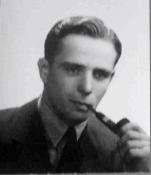
|
The King's School Canterbury |
Roll of Honour |
| Flying Officer William Torrens HINDS (129948) | |
|
54 Squadron Royal Air Force Date of birth: 15th December 1921 Date of death: 7th September 1943 Killed in action aged 21 Buried at Adelaide River War Cemetery Plot G Row C Grave 7 |

|
| He was born at Ashford on the 15th of December 1921, the only son of William Geoffrey Hinds, traveller, and Doreen (nee Kenny) of Gillett's Grange, Smarden. Kent. He was educated at Harvey Grammar School, Folkestone, and at the King's School Canterbury from September 1936 to July 1940, where he was in Meister Omers and won his colours for Athletics. On leaving school he joined the Royal Air Force Volunteer Reserve and rose to the rank of Sergeant (1330820). He trained as a pilot in Canada under the Empire Air Training Scheme, was commissioned as a Pilot Officer on the 15th of August 1942 and was posted to 234 Squadron. On the 17th of February 1943 he was promoted to Flying Officer (probationary) and was posted on the same day to 54 Squadron based in Australia. The squadron operated Spitfires out of Parap Airfield in Darwin where they were principally involved in defending Darwin against attacks by Japanese bombers. He arrived at the squadron on the 27th of April 1943. In June 1943 he wrote a letter to the Headmaster of King's:- "The nips don't visit regularly enough to get in some real practising. To keep us company at night mosquitoes, sandflies, large spiders, lizards and cockroaches have their frolics, not to mention the odd snake which occasionally uses a flying boot for his evening nap. My impression after geography lessons at school was that Australia was a large very uninhabitable place, where the cities were small and old fashioned. I was surprised to find that Adelaide for instance was the most perfectly planned and prettiest city I had ever seen. Also it has the best cinemas I have encountered outside New York. This country holds endless possibilities for agriculture, engineering and irrigation, and I am, if possible after the war, going to stay out here to see what I can do. Imagine my surprise when I saw in the "Kentish Express" way out in the bush here, that the school had been awarded a shield for Life Saving. I bet Mr Goodburn is bucked." On the 6th of July 1943 the squadron was scrambled to meet an incoming raid of around twenty seven enemy bombers and twenty three fighters which were heading for the US Liberator base at Fenton. William Hind was flying Spitfire A58-31 BR895 and was climbing for the interception when his engine overheated due to an oil pressure drop and he was forced to crash land on a beach at Port Patterson. Although he was unhurt the aircraft was a write off. At 8.30pm on the morning of the 7th of September 1943 the first warnings were received by the defenders of Darwin that a Japanese twin engined reconnaissance aircraft had been picked up on radar. Twelve aircraft of 457 Squadron were scrambled to intercept. It soon became clear that the enemy aircraft had a large escort of fighters and as a result both 452 and 54 Squadrons were also scrambled. As the pilots of the two squadrons neared Port Patterson they saw a large gaggle of twenty one enemy aircraft some sixteen miles to the west of Sattler but, while they were still climbing, they were engaged by the Japanese fighters who had a clear height advantage. During the melee which followed two Spitfires of 452 Squadron were shot down with both pilots managing to bail out. The British pilots claimed a Zero fighter destroyed with two more probably destroyed but 54 Squadron also reported that one of their pilots William Hinds, who had been flying Spitfire MkVc EF558, was missing. The following day his burnt out Spitfire was found twenty miles to the south south east of Parap airfield and fifteen miles to the west of Strauss airfield in the vicinity of Kangaroo Flats near Pioneer Creek. Due to the fire that followed the crash, which had set fire to some of the surrounding bush, the rescue team was unable to recover his body until the 13th of September. He was identified by a cigarette case and a revolver which had been thrown clear of the wreckage. He was buried on the 14th September 1943 at the Berrimah War Cemetery but two years later, on the 9th September 1945, his body was exhumed and reinterred at its present location. The Cantuarian wrote:- "If there was one characteristic about him which could not fail to impress it was his immense vitality. Whatever he had to do was done always with outstanding vigour and enthusiasm. He was indeed the very pattern of youth, a happy mixture of adventurousness and conservatism. These were the characteristics which made him an outstanding fighter pilot, and they are the same which will be so sadly missed in a world which has great need of young men of this type. He will have been happy to die doing a plain straightforward job for a cause in which he believed; our gratitude for his sacrifice must be mingled with a deep sense of personal loss." |
|
| Meister Omers |
Back